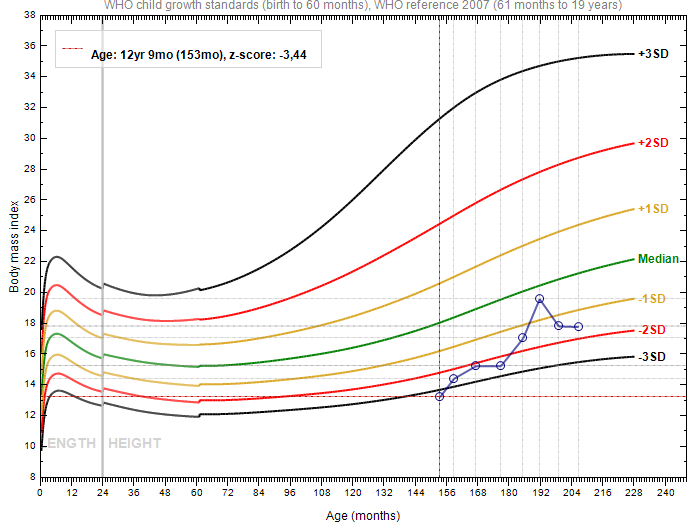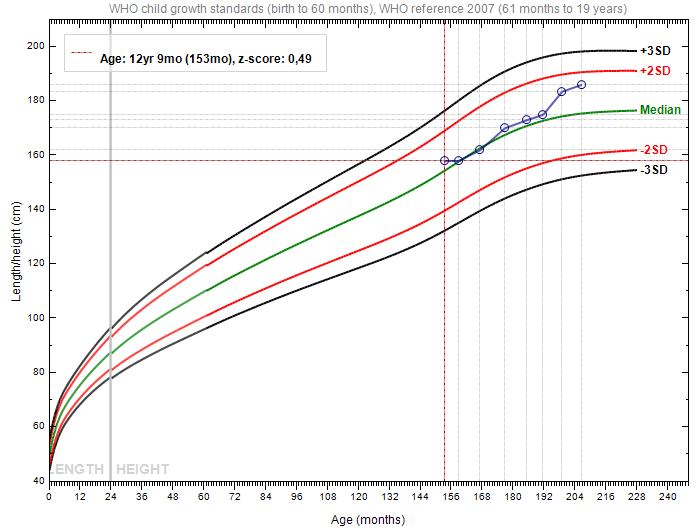Suspected Dermatitis herpetiformis and Coeliac disease

A 12-year-old boy was referred to our department because of of abdominal pain and loose stools lasting for a couple of months with up to 3 bowel movements per day. At the visit, failure to thrive was also noticed.
From the previous history – The child was born on term, breastfed for a couple of months, vaccinated regularly, no developmental delays, nothing remarkable from family history. He had frequent acute infections of the upper respiratory tract till 7 years of age, no allergies. The child developed dermatitis herpetiformis, biopsy proven, which was diagnosed in another institution one year before. At that time immunological tests for coeliac disease were done – normal total IgA, anti TTG IgA, IgG, DGP antibodies were negative. The rash was treated on demand with Dapsone.
Upon admission to our hospital in the beginning of December 2016, the boy had weight of 33kg, height 158 cm, which plotted on the WHO curves corresponded to BMI-for-age Z- score -3,44, Height-for-age Z-score 0,49. On examination head, skin, lymph nodes, cardiovascular system, respiratory system, extremities were – normal. Thyroid gland was enlarged, abdomen was protuberant, nontender, no signs of organomegaly, normal bowel sounds.
Laboratory blood tests – most of the biochemical tests were normal, including Hb, DBC, iron status, liver transaminases, biochemical test for kidney function, electrolytes, thyroid gland biomarkers, urinalysis. Biochemical tests for active inflammation were normal. However, blood lactose intolerance test proving lactase deficiency was pathologic. From a wide panel of immunological tests, we found only abnormal level of Antinuclear antibodies. Total IgA, anti TTG IgA and IgG were again negative, as well as AGA IgA negative, only IgG slightly positive (3,37IU/ml). Stool microbiology and calprotectin were negative too. Abdominal ultrasound and ultrasound of the thyroid gland were normal. Barium series was performed and a decision was taken to perform also upper endoscopy, which was found to be macroscopically normal. Histological examination found no increased IELs, no subtotal villous atrophy and no crypt hyperplasia, but only minor chronic duodenal inflammation. HLA genotyping was done – negative for HLA-DQ2 and HLA-DQ8.
The boy was repeatedly admitted to the ward with similar complaints and with similar findings from biochemistry. Due to financial limitations anti-endomysium antibodies (EMA) IgA were not performed. Short term lactose-free and long-term gluten-free diets were introduced.
The skin rash due to dermatitis herpetiformis disappeared after a couple of months on gluten-free diet and growth improved as could be seen from the growth charts.
Questions:
- Is it possible that this is celiac disease with negative serology and negative HLA DQ2 and DQ8?
- Should the diagnosis of dermatitis herpetiformis be questioned?
- Should gluten-free diet be continued or should gluten challage be performed?


Expert’s answer:
- Dermatitis herpetiformis (DH) should be DQ2 or DQ8 positive. It would be nice to hear about the complete histopathology of the skin biopsy and about histology of intestinal biopsy. Light microscopic description of skin biopsy is not a sufficient proof. It should be checked whether direct immunofluorescence was performed, showing the IgA deposits in the skin. Otherwise it could have been some other type of food-induced dermatitis (allergy, atopy etc).
- What kind of HLA typing was performed? Was it a gene typing, or was it lymphocyte typing? If it was the gene typing, and HLA DQ2 and DQ8 came back negative, he should be tested for HLA DQ7 also.
- Regarding celiac disease, it is unlikely to be celiac with negative HLA and double negative serology. Nice to hear that the boy is recovering but would be very reluctant to call him any type of gluten dependant. He should definitely have a gluten-challenge, but not during the pubertal growth. In the meantime, should check for any missing pieces.